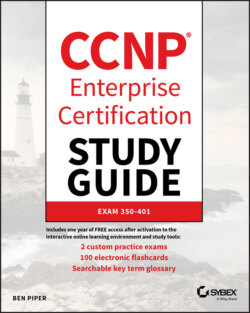Читать книгу CCNP Enterprise Certification Study Guide: Implementing and Operating Cisco Enterprise Network Core Technologies - Ben Piper, David Higby Clinton - Страница 37
Forwarding between Subnets
ОглавлениеOn the other hand, if Host A (192.168.70.3) attempts to ping Host B (192.168.70.67), the following happens:
1 Host A compares its IP address with Router B's IP and determines that they are in different subnets.
2 Host A consults its IP routing table for a closest-match route to 10.255.70.1. Not finding an exact match, the closest match is the default route (0.0.0.0/0). Host A's default gateway is 192.168.70.62, the IP belonging to Router A's Ethernet interface.
3 Because Router A's and Host A's IP addresses are in the same subnet, Host A sends an ARP request asking for Router A's MAC address.
4 Switch A floods the ARP request to Router A.
5 Router A sends an ARP reply to Host A's MAC address. The reply contains Router A's IP address and MAC address.
6 Host A encapsulates the IP packet inside an Ethernet frame addressed to Router A's MAC address. The Type field will contain the value 0x0800 to indicate that the Data field contains an IP packet.
7 Router A receives the Ethernet frame and, based on the Type field in the Ethernet frame, knows it contains an IP packet.
8 Router A looks at the destination IP address in the IP packet and checks its forwarding information base (FIB) for an exact match. Cisco Express Forwarding (CEF) uses the FIB to make forwarding decisions. The FIB is fed by the IP routing table (also known as the Routing Information Base, or RIB). Not finding an exact match for the destination IP address in the FIB, it will use the default route, which has Router B (10.255.70.1) as its next hop.
9 Router A will encapsulate the IP packet in a PPP frame and send it to Router B.
10 Router B will decapsulate the IP packet, look at the destination IP address, and check its FIB for a match. Because the destination IP (192.168.70.67) is in the same subnet as Router B's Ethernet interface, Router B will send an ARP request.
11 Switch B will flood the ARP request to Host B, which will send an ARP reply to Router B's MAC address. The ARP reply will contain Host B's MAC address and IP address.
12 Router B will encapsulate the IP packet in an Ethernet frame addressed to Host B's MAC address.
The reason that the process takes so many steps is that the ICMP data is zigzagging up and down the different layers at each node. Figure 1.6 puts everything in context with a layered view of the topology.
Figure 1.6 Layered representation of the network
It's worth noting that when you create multiple VLANs on a switch, you're simply creating separate broadcast domains. Nodes in one VLAN can't communicate with nodes in the other using MAC addresses because they're in different subnets. Even if those nodes are connected to the same switch, they must use IP and go through a router to communicate with nodes in the other VLAN.
It's crucial that a CIDR block belong to only one subnet—that is, one section of the network where all the connected nodes use the same Data Link layer protocol. A common mistake is to try to split a CIDR across different subnets that are usually in geographically separated areas, like different data centers. The rationale for subnet splitting is to achieve some sort of resiliency with minimal inconvenience, particularly by being able to migrate virtual machines from one site to another without changing any IP addresses. This requires using some network virtualization technology like Virtual Extensible LAN (VXLAN) to create the illusion of extending the subnet, when in fact it's stuffing Ethernet frames inside of IP packets and sending them across multiple subnets, in essence creating a virtual subnet! Remember that a subnet can't scale beyond a few hundred nodes—not even a virtual subnet.
